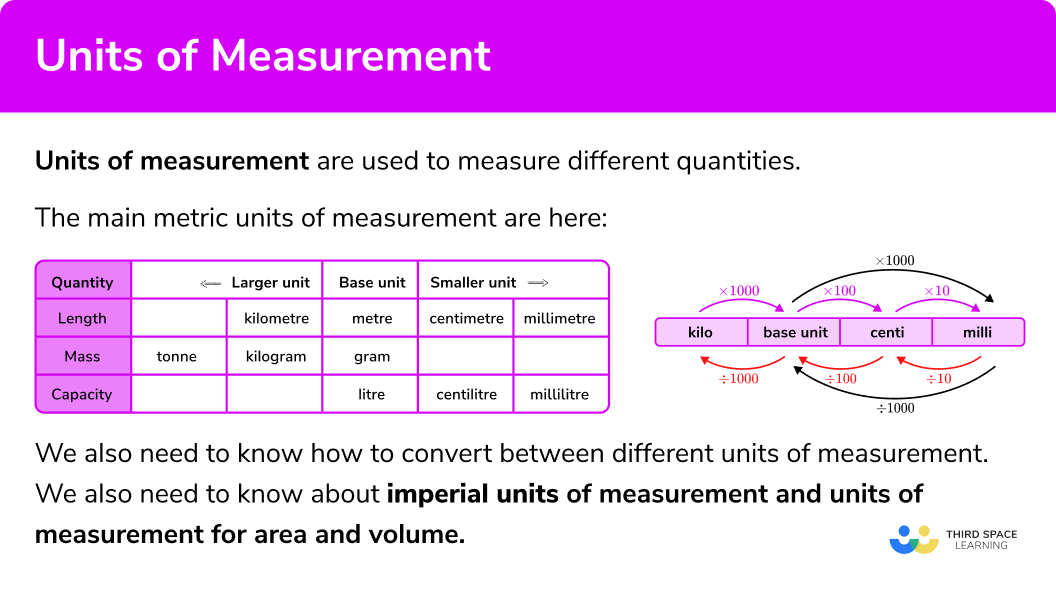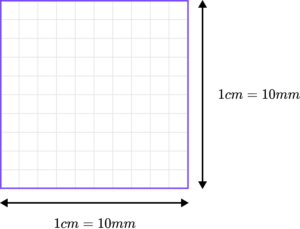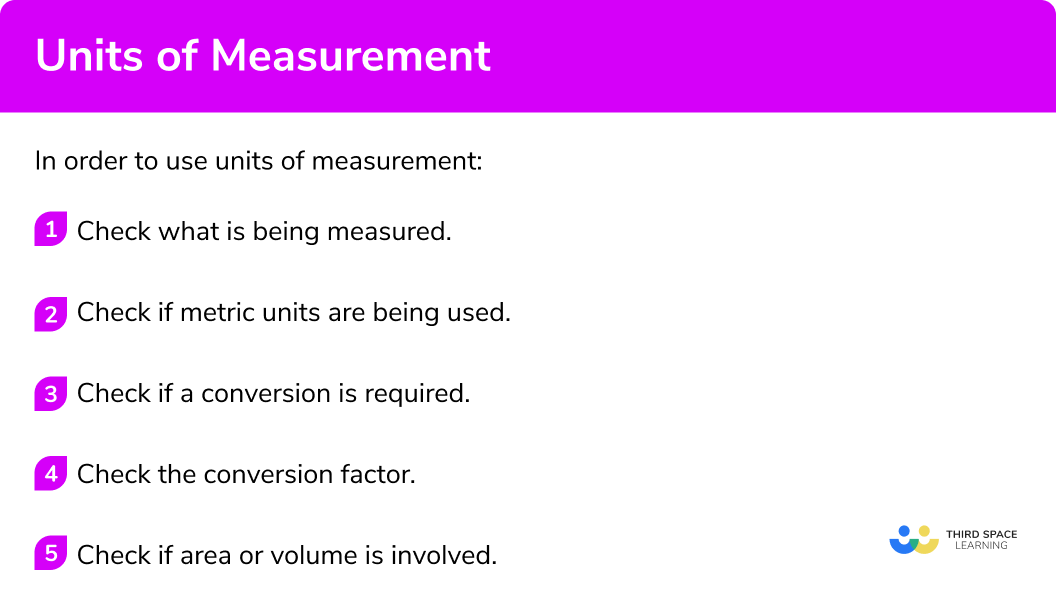GCSE Tutoring Programme
Our chosen students improved 1.19 of a grade on average - 0.45 more than those who didn't have the tutoring.
In order to access this I need to be confident with:
Place value Factors and multiples Multiplying fractions Dividing fractions Multiplying decimals Dividing decimals ArithmeticThis topic is relevant for:

Units Of Measurement
Here we will learn about units of measurement from the metric system and imperial system including how to convert between them.
There are also units of measurement worksheets based on Edexcel, AQA and OCR exam questions, along with further guidance on where to go next if you’re still stuck.
What are units of measurement?
Units of measurement are used to measure different quantities.
What are units of measurement?

Metric units of measurement
Metric units of measurement are the measurements which are used internationally.
Metric standard units form part of the international system of units (SI units) and use a variety of abbreviations for common units.
For example,
The metric unit of measurement for length is the metre (m) ,
The metric unit of measurement for mass is the gram (g),
The metric unit of measurement for capacity is the litre (l).
For smaller quantities or larger quantities we can adapt the metric units of measurement. The main ones used are kilo, centi and milli:
Step-by-step guide: Metric units of measurement
Imperial units of measurement
Imperial units of measurement are an older system of measurements but some are still used in everyday life.
For example,
1 \;inch ≈ 2.5 \;cm 1 \;foot ≈ 30 \;cm 1 \;mile ≈ 1.6 \;kmConversion of units
Conversion of units is when we need to change from one unit to another. This may be between imperial units and metric units.
For example,
5 \;miles ≈ 8 \;kilometresStep-by-step guide: Conversion of units
Converting metric units
Converting metric units is when we convert between different metric units of measurement by multiplying or dividing by powers of 10.
For example,
7.1 \;cm ≈ 71 \;mmStep-by-step guide: Converting metric units
Converting units of area and volume
Converting units of area and volume allows us to convert between different metric units in questions involving area and volume.
We do this by adapting how we convert units of length.
Step-by-step guide: Converting units of area and volume
Converting units of time
Converting units of time is when we have information about time in one unit, but we need to change the time into a different unit.
We need to know that:
1 hour = 60 minutes
1 minute = 60 seconds
For example,
Give 3.2 hours as hours and minutes.
0.2\times 60=12 minutes.
3.2 hours is 3 \; hours and 12 minutes
Step-by-step guide: Converting units of time
Converting units of length
Converting units of length is when we have information about a length in one unit, but we need to change the length into a different unit.
For example we could be given a height of a person in centimetres, but need to convert it to metres.
For example, 174 cm = 1.74 m.
Converting units of mass, time, area
Converting units also extends to units other than length. It can include mass, times or areas.
For example we could be given a mass in kilograms, but need to convert it to grams.
For example, 1.26 kg = 1260 g.
This is because there are 1000 grams in 1 kilogram.
For example we could be given a time in hours, but need to convert it to minutes.
For example, 3.4 hours = 204 minutes.
This is because 1 hour is 60 minutes, so 3 hours will be 180 minutes. 0.4 of an hour is 24 minutes. So 3.4 hours will be 204 minutes.
For example we could be given an area in square centimetres and asked to convert to square millimetres.
For example, 7.2 cm2 = 720 mm2.
This is because 1 square centimetre is 100 square millimetres.

How to use units of measurement
In order to use units of measurement:
- Check what is being measured.
- Check if metric units are being used.
- Check if a conversion is required.
- Check the conversion factor.
- Check if area or volume is involved.
Explain how to use units of measurement

Units of measurement worksheet
Get your free units of measurement worksheet of 20+ questions and answers. Includes reasoning and applied questions.
COMING SOONUnits of measurement worksheet
Get your free units of measurement worksheet of 20+ questions and answers. Includes reasoning and applied questions.
COMING SOONUnits of measurement examples
Example 1: choosing a metric unit of measurement
Write down a sensible metric unit of measurement for:
The weight of a packed suitcase.
- Check what is being measured.
The weight of an object is being measured. So we need to consider units of mass.
- Check if metric units are being used.
The question asks for metric units, so we need to consider grams or kilograms.
Kilograms would be the most sensible metric unit of measurement for a packed suitcase.
Example 2: conversion of units – metric/imperial
Use 1 \; inch \; 2.54 \; cm
Convert:
5 \; inches to cm
Check if a conversion is required.
The question is a conversion question. We are converting from inches to centimetres. Inches is an imperial unit of length and centimetres is a metric unit.
Check the conversion factor.
The conversion factor is given to us. To go from inches to centimetres we multiply by 2.54 .
So,
5\times 2.54=12.7
5 \; inches is approximately equal to 12.7 \; cm
Example 3: conversion of units – metric/imperial
Use 5 \; miles \; ≈ \; 8 \; km
Convert:
60 \; miles to km
Check if a conversion is required.
The question is a conversion question. We are converting from miles to kilometres. Miles is an imperial unit of length and kilometres is a metric unit.
Check the conversion factor.
The conversion factor is given to us. To go from miles to kilometres we multiply by \frac{8}{5} .
So,
60\times \frac{8}{5}=96
60 \; miles is approximately equal to 96 \; km
Example 4: conversion of units – speed
Convert:
8 \; m/s to km/h
Check if a conversion is required.
The question is a conversion question. We are converting from metres per second (m/s) to kilometers per hour (km/h) .
Check the conversion factor.
There are 3 conversions needed for this question. The conversion factor for seconds to minutes is 60 . The conversion factor for minutes to hours is also 60 .
The conversion factor for metres to kilometers is 1000.
First convert to metres per minute by multiplying by 60 .
8\times 60=480
Then, convert to metres per hour by multiplying by 60 .
480\times 60=28\ 800
Finally, convert to kilometres per hour by dividing by 1000 .
28 \ 800\div 1000=28.8
8 \; m/s is approximately equal to 28.8 \; km/h
Example 5: converting metric units
Convert:
9.6 \; l to ml
Check if metric units are being used.
l is the symbol for litres and ml is the symbol for millilitres. These are metric units of capacity.
Check if a conversion is required.
The question is a conversion question. We are converting from litres (l) to millilitres (ml) .
Check the conversion factor.
The conversion factor for litres to millilitres is 1000 . We need to multiply by 1000.
9.6\times 1000=9 \ 600
9.6 \; l is approximately equal to 9 \ 600 \ ml
Example 6: converting metric units
Convert:
780 \; cm to m
Check if metric units are being used.
cm is the symbol for centimetres and m is the symbol for metres. These are metric units of length.
Check if a conversion is required.
The question is a conversion question. We are converting from centimetres (cm) to metres (m) .
Check the conversion factor.
The conversion factor for centimetres to metres is 100 . We need to divide by 100.
780\div 100=7.8
780 \; cm is equal to 7.8 \; m
Example 7: converting units of area and volume
Convert:
2.3 \; cm^2 to mm^2
Check if metric units are being used.
cm^2 is the symbol for square centimetres and mm^2 is the symbol for square millimetres. These are metric units of area.
Check if a conversion is required.
The question is a conversion question. We are converting from square centimetres (cm^2) to square millimetres (mm^2) .
Check the conversion factor.
The conversion factor for centimetre to millimetres is 10.
Check if area or volume is involved.
Square units for area are involved. Therefore we need to multiply by 10^2.
2.3\times 10^2 =2.3\times 100=230
2.3 \; cm^2 is equal to 230 \; mm^2
Example 8: converting units of time
Convert:
2.7 hours to minutes
Check what is being measured.
Time is being measured. We need to remember that there are 60 seconds in a minute and 60 minutes in an hour.
Check the conversion factor.
The conversion factor for hours to minutes is 60. Therefore we multiply by 60. .
2.7\times 60=162
2.7 hours is equal to 162 minutes
Common misconceptions
- Multiply or divide?
Remember:
– if you are going from larger units to smaller units – multiply
– if you are going from smaller units to larger units – divide
- Prefix
A common error is to mix up the different prefixes i.e. milli, kilo, centi etc.
- Fractions of an hour
Remember that time is not a decimal system based on 10 . A quarter of an hour is 15 minutes. But one quarter as a decimal is 0.25 . E.g. 3.25 hours is 3 hours and 15 minutes. Similarly 1\frac{1}{2} days is 1 day and 12 hours.
Practice units of measurement questions
1. Choose the most sensible metric unit to measure:
The volume of a coffee cup
grams

pints

millilitres

litres

We need a unit for capacity – so grams can be ruled out. We need a metric unit – so pints can be ruled out. The volume of a teaspoon is very small, so millilitres are the best unit.
2. Use the conversion 1 \; foot ≈ 0.3 \; m, convert 4.5 \; m to feet:




We need to divide by 0.3
4.5\div 0.3=15
So 4.5 \; m is approximately 15 \; feet
3. Convert: 5.3 \; l to ml




Converting litres to millilitres we multiply by 1000.
5.3 \times 1000=5300
So 5.3 \; l is approximately 5300 \; ml
4. Convert: 18 \; km/h to m/s




Converting kilometres to metres we multiply by 1000.
Converting to metres per hour
18 \times 1000 =18\ 000
Converting to metres per minute
18\ 000 \div 60 = 300
Converting to metres per minute
300 \div 60 = 5
So 18 \; km/h is equal to 5 \; m/s
5. Convert: 700 \; mm^2 to cm^2




Converting square millimetres to square centimetres we divide by 10^2 .
700 \div 10^2 = 700 \div 100 = 7
So 700 \; mm^2 is equal to 7 \; cm^2
6. Convert: 2 \; m^3 to cm^3




Converting cubic metres to cubic centimetres we multiply by 100^3 .
2 \times 100^3 = 2 \times 1 \ 000 \ 000 = 2 \ 000 \ 000
So 2 \; m^3 is equal to 2 \ 000 \ 000 \; cm^3
Units of measurement GCSE questions
1. Circle the best metric unit of measurement for:
The weight of a horse
litres kilograms pounds grams
(1 mark)
Kilograms
(1)
2. A bottle contains 1.5 litres of cola.
A can contains 330 \; ml of cola.
Charlier has 3 bottles of cola and 4 cans of cola.
How much cola do they have in total?
Give your answer in millilitres.
(3 marks)
(1)
3 \times 1500+4 \times 330
(1)
5820 \; ml
(1)
3. Write 42 \; cm^3 in mm^3
(2 marks)
(1)
42 \ 000
(1)
4. Randeep is going from London to the Belgian town of Bruges.
Randeep will drive from London to Dover.
He will then drive from Calais to Bruges.
The distance from London to Dover is 77.5 \; miles.
The distance from Calais to Bruges is 115 \; km.
Use 5 \; miles ≈ 8 \; km
Randeep has enough fuel in her car to drive 140 \; miles.
Does he have enough fuel to get from London to Bruges?
You must show all your working.
(3 marks)
(1)
77.5+71.875=149.375
(1)
No – Randeep does not have enough fuel.
149.375 is greater than 140 \; miles.
(1)
Learning checklist
You have now learned how to:
-
Choose metric units
-
Convert metric units of length, mass and capacity
-
Convert metric and imperial units
-
Convert units of speed
-
Convert units of area and volume
The next lessons are
Still stuck?
Prepare your KS4 students for maths GCSEs success with Third Space Learning. Weekly online one to one GCSE maths revision lessons delivered by expert maths tutors.

Find out more about our GCSE maths tuition programme.